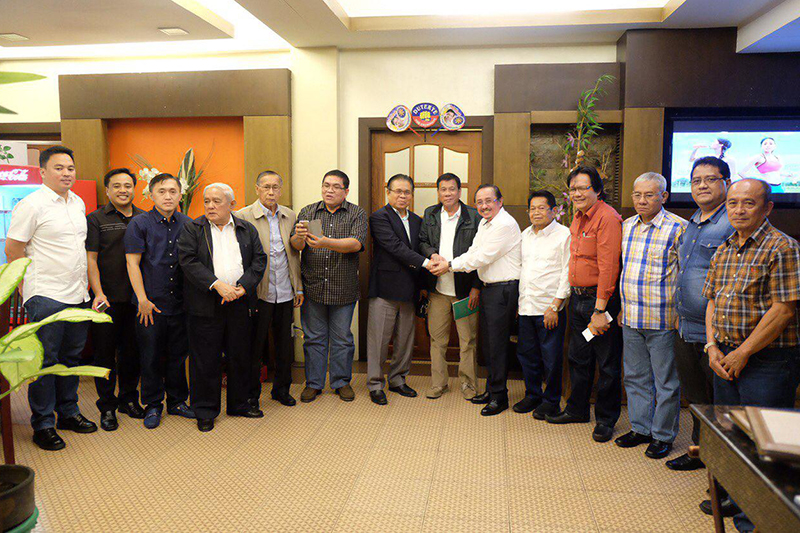
Moro Islamic Liberation Front chairman Al Haj Murad Ebrahim (left of Duterte) and Moro National Liberation Front leader Datu Abul Khayr Alonto (right of Duterte) shake hands. Photo from Duterte camp, file
Some people always talk about the end as if it were certain.
Sixteen years ago, President Joseph Estrada talked about ending a people’s struggle. He talked about ending it with war. In the summer of 2000, he sent state forces to Maguindanao with the intent of seizing Camp Abubakar, a camp that spanned four Maguindanao towns -- Matanog, Barira, Buldon and Parang -- and stretched out into the towns of Kapatagan, Balabagan, and Butig in Lanao del Sur.
It was where then Moro Islamic Liberation Front chairman and founder Salamat Hashim and then vice chair for military affairs and head of the Bangsamoro Islamic Armed Forces Al-Haj Murad Ebrahim lived and held office.
In Camp Abubakar was the heart of the Bangsamoro’s political and armed struggle.
It wasn't some hidden, far-flung camp unknown to everyone who wasn't an MILF member. It was an identified MILF territory and, as with all MILF camps, it was protected by a defense system that many tend to underestimate.
Deep trenches from which MILF troops lie in wait with the intent of protecting the camp were strategically placed along the camp’s perimeter, while the terrain itself made the camp almost impenetrable.
Mountains and rivers surrounded the camp, forming a natural boundary which placed the MILF troops at an advantage against their enemies.
Above all else, it was a community, a place where a bustling Muslim community thrived.
Here, public markets and small businesses flourished, children went to schools and the people went to pray in mosques, families of MILF members lived together and called the camp home.
But that didn’t matter, not to the president at least. All those lives didn’t matter. We were at war, he said, and the Bangsamoro struggle can only be resolved by seizing the main enclave of the front.
On July 10, 2000, government troops finally seized Camp Abubakar after two months of intense firefight. People were killed and wounded, thousands of families were displaced. But that wasn’t enough for the president.
Sixteen years ago, Estrada sent military forces to seize an MILF stronghold, a moment of false triumph in a continuing history of conflict. Estrada then went to see what remained of the camp, and the destruction pleased him.
Together with members of the military, he celebrated by bringing in lechon and beer to a mosque, eating what counts for sin on hallowed ground, surrounded by a camp destroyed and a people’s deepening resolve. It was a spectacle, not a victory.
The Estrada administration spent over a billion pesos to crush the MILF, but 16 years later, the MILF is stronger than ever -- showing strength by pursuing the path of peace instead of war, showing that it can and has gone beyond a former president's seemingly ignorant approach to conflict resolution.
But what happened 16 years ago will never be forgotten. The Bangsamoro people still remember the fall of Camp Abubakar for what it actually was -- a moment of disgrace in a presidency that hardly set the standard for anything good in this country.
The struggle lives on.
It was only about a couple of years ago when people started to talk about the end of the Autonomous Region in Muslim Mindanao, with the hope of eventually transitioning to the Bangsamoro. The peace negotiations seemed to be bearing fruit, the panels finally making headway in a decades-long negotiation that has seen way too many losses.
That was until a police operation went wrong, and then came the inevitable accounting of faults – who violated the ceasefire agreement, who failed to disclose vital information, who failed in keeping their commitments? As the senators began talking about the end of negotiations, at least until the next administration, congressmen talked about the end of deliberations, at least until their interpretation of the constitution matches the legislation for a genuine autonomous region.
Former President Estrada, now speaking beyond his relevance, then showed that his approach to the Bangsamoro struggle hardly changed. In an interview following the encounter in Maguindanao, he said, “the only solution is an all-out war.”
But the struggle goes beyond armed conflict, with wounds far deeper than those inflicted by gunfire.
It has been sixteen years since the fall of Camp Abubukar, but the struggle did not end with the dismantling of camps and death of Moro revolutionaries. As long as there is a refusal to confront the truths of our shared history, as long as there is a failure to understand and celebrate our differences, and as long as there is a child who longs to belong in a country she calls home, the struggle will not end.
The struggle never ends for the oppressed.
[The author moved to Cotabato City in 2012 and has been working in, and with, the Bangsamoro for the past four years.]

No comments:
Post a Comment
Note: Only a member of this blog may post a comment.